SHALOM!
Crossing over
From:

To:
Numbers 29:1-6 New King James Version (NKJV)
Offerings at the Feast of Trumpets
29 ‘And in the seventh month, on the first day of the month, you shall have a holy convocation. You shall do no customary work. For you it is a day of blowing the trumpets. 2 You shall offer a burnt offering as a sweet aroma to the Lord: one young bull, one ram, and seven lambs in their first year, without blemish. 3 Their grain offering shall be fine flour mixed with oil: three-tenths of an ephah for the bull, two-tenths for the ram, 4 and one-tenth for each of the seven lambs; 5 also one kid of the goats as a sin offering, to make atonement for you; 6 besides the burnt offering with its grain offering for the New Moon, the regular burnt offering with its grain offering, and their drink offerings, according to their ordinance, as a sweet aroma, an offering made by fire to the Lord.
-
YOM TERUAH = DAY OF SOUNDING (OF TRUMPETS) a.k.a FEAST OF TRUMPETS
-
YOM TERUAH is also known as the FEAST OF ROSH HA SHANAH meaning START OF THE YEAR.
-
YOM TERUAH = the Creation of the world’s birthday
The Hebrew Calendar Year 5779 is coming to an end.
The Hebrew Calendar Year 5780 is about to commence. Note that numbers are of great significance to YAH (a.k.a GOD) the creator of all things.
The numbers 5, 7, 8, 0 have a spiritual significance.
Praise YAH for the NEW YEAR!!!
Rosh Hashanah is a Jewish holiday marking the first and second days of the Jewish year. (In 2019, Rosh Hashanah begins at sundown on September 29th) and continues through nightfall on October 1st).
It’s the day on which YAH/ELOHIM created Adam and Eve, and it’s celebrated as the head of the Jewish year.
How do we observe the YOM TERUAH a.k.a ROSH HA SHANAH?
The following video gives some useful information:
Video: Rosh ha Shanah 2018 Celebration With Amightywind!
Rosh Hashanah Is Celebrated With:
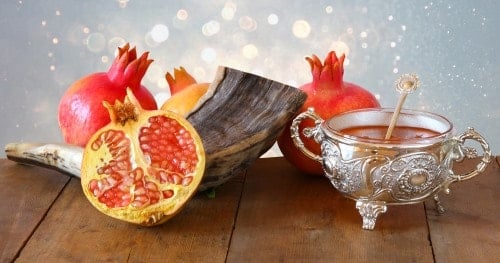
- Hearing the sounding of the ram’s horn (shofar) on both mornings
- Lighting candles each evening
- Eating festive meals with sweet delicacies during the night and day, which include:
- Kiddush over wine or grape juice
- Round, raisin challah bread dipped in honey
- Apples dipped in honey (on the first night)
- The head of a fish, pomegranates, and other foods symbolizing our wishes for the coming year (on the first night)
- A new fruit (on the second night)
- Performing Tashlich, a brief prayer said at a body of fresh water
- Attending services in synagogue
- Desisting from creative work
The Shofar-Blowing:
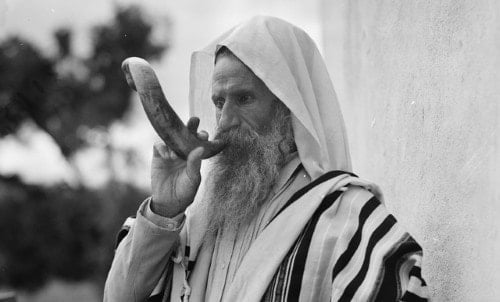
The central observance of Rosh Hashanah is hearing the sounding of the shofar, the ram’s horn. It is a mitzvah to hear the shofar on both mornings of the holiday (except if the first day is Shabbat, in which case we only blow the shofar on the second day).
The first 30 blasts of the shofar are blown following the Torah-reading during morning services, and as many as 70 are then blown during (and immediately after) the Musaf service. For someone who cannot come to synagogue, the shofar may be blown the rest of the day.
Candle-Lighting:
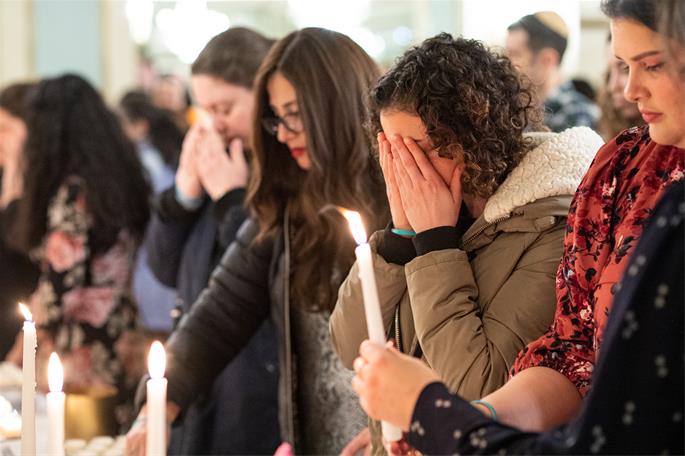
As with every major Jewish holiday, women and girls light candles on each evening of Rosh Hashanah and recite the appropriate blessings. On the second night (or if lighting after nightfall on the first night), make sure to use an existing flame. Think about a new fruit that you will be eating (or garment that you are wearing) while you say the Shehechiyanu blessing.
Girls and all women who are in the house (or if there isn’t a woman in the house, the head of the household), light candles to usher in each night of the holiday. See Procedure for Holiday Candle Lighting for detailed holiday candle-lighting information.
Blessings for the evenings of September 9th and 10th, 2017:
1) Ba-ruch A-tah Ado-nai E-lo-hei-nu me-lech ha-olam asher ki-deshanu be-mitzvo-tav ve-tzvi-vanu le-hadlik ner shel Yom Hazikaron.
Blessed are You, ABBA YAHUVEH our GOD, King of the universe, who has sanctified us with His commandments and has commanded us to light the candle of the Day of Remembrance.
[Note: When reciting the following blessing on the second night of the holiday, one should have in mind the new fruit which one will subsequently be eating after Kiddush.]
2) Ba-ruch A-tah Ado-nai E-lo-hei-nu me-lech ha-olam she-heche-ya-nu ve-ki-yi-ma-nu ve-higi-a-nu liz-man ha-zeh
Blessed are You, ABBA YAHUVEH our GOD, King of the universe, who has granted us life, sustained us, and enabled us to reach this occasion.
After reciting the holiday candle-lighting blessing, the Shehecheyanu blessing is recited, thanking G‑d for giving us the life and strength to reach this special day.
Festive Meal:
We eat festive meals every night and day of the holiday. Like all other holiday meals, we begin by reciting kiddush over wine and then say the blessing over bread. But there are some important differences, as we’ll explain below.
When Rosh Hashanah occurs on Shabbat, say all the pre-Shabbat Kiddush prayers (such as Shalom Aleichem and Aishet Chayil) in an undertone before starting Kiddush.
On the second night of Rosh Hashanah, it is customary to place a new fruit [not yet eaten this season] before the one who makes Kiddush; he is to glance at it while reciting the Shehecheyanu(“Who has granted us life…”) blessing , bearing in mind that it applies to the new fruit as well.
Stand while reciting the Kiddush. Those listening to the Kiddush should respond “Amen” as indicated.
Take the cup of wine in the right hand and glance at the festival candles. The cup should be held at least three handbreadths (approximately 9 in.) above the table throughout the Kiddush.
On Shabbat, begin here.
The sixth day. And the heavens and the earth and all their hosts were completed. And YAH finished by the Seventh Day HIS work which HE had done, and HE rested on the Seventh Day from all HIS work which He had done. And YAH blessed the Seventh Day and made it holy, for on it HE rested from all HIS work which YAH created to function.
On weeknights, begin here.
Glance at the wine and say:
Attention, Gentlemen and Ladies!
Blessed are You, ABBA YAHUVEH our GOD, King of the universe, who creates the fruit of the vine. [Amen]
On Shabbat, add the words in parentheses.
Blessed are You, ABBA YAHUVEH our GOD, King of the universe, who has chosen us from among all nations, raised us above all tongues, and made us holy through His commandments. And You, ABBA YAHUVEH our GOD, have given us in love (this Shabbat day and) this Day of Remembrance, the festival of holy assembly,2 a day for (the remembrance of) sounding the shofar, (in love,) a holy assembly, commemorating the Exodus from Egypt. For You have chosen us and sanctified us from among all the nations, and Your word, our King, is true and enduring forever. Blessed are You ABBA YAHUVEH, King over all the earth, who sanctifies (the Shabbat and) Israel and the Day of Remembrance. [Amen]
When Rosh Hashanah occurs on Saturday night, add the following:
Blessed are You, ABBA YAHUVEH our GOD, King of the universe, who created the lights of fire. [Amen]
Glance at the festival lights, then continue:
Blessed are You, ABBA YAHUVEH our GOD, King of the universe, who makes a distinction between sacred and profane, between light and darkness, between Israel and the nations, between the Seventh Day and the six work days; between the holiness of the Shabbat and the holiness of the Festival You have made a distinction, and have sanctified the Seventh Day above the six work days. You have set apart and made holy Your people Israel with Your holiness. Blessed are You ABBA YAHUVEH, who makes a distinction between holy and holy. [Amen]
Blessed are You, ABBA YAHUVEH our GOD, King of the universe, who has granted us life, sustained us and enabled us to reach this occasion. [Amen]
Pour some wine from the cup to be distributed to those listening, and drink at least 2 ounces of the remaining wine while seated.
Round Challah in Honey:
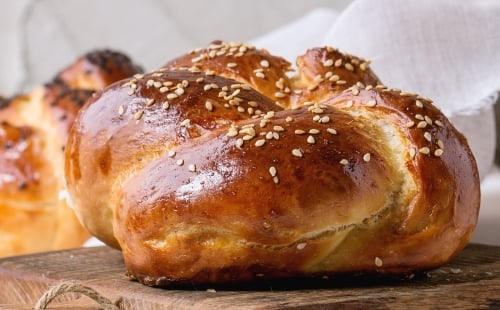
The bread (traditionally baked into round challah loaves, and often sprinkled with raisins) is dipped into honey instead of salt, expressing our wish for a sweet year. We do this on Rosh Hashanah, Shabbat Shuvah (the Shabbat before Yom Kippur), in the pre-Yom Kippur meal and during Sukkot.
Apples in Honey:
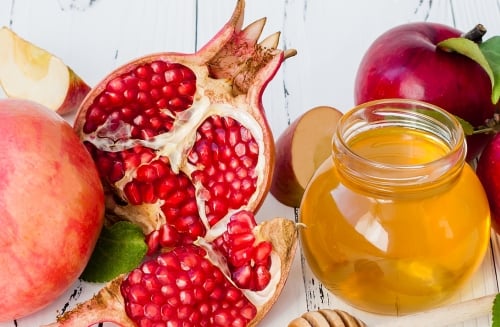
Furthering the sweet theme, it is traditional to begin the meal on the first night with slices of apple dipped in honey. Before eating the apple, we make the ha’eitz blessing and then say, “May it be Your will to renew for us a good and sweet year.”
Fish Head and Pomegranates:
Many people eat parts of the head of a fish or a ram, expressing the wish that “we be a head and not a tail.”
In many communities, there are additional traditional foods eaten, each symbolizing a wish for the coming year. Many eat pomegranates, giving voice to a wish that “our merits be many like the [seeds of the] pomegranate.” Another common food is tzimmes, a sweet, carrot-based dish eaten because of its Yiddishname, merren, which means both “carrot” and “increase,” symbolizing a wish for a year of abundance.
(Read about the elaborate array of symbolic foods eaten in Sephardic communities here.)
Keep It Sweet:
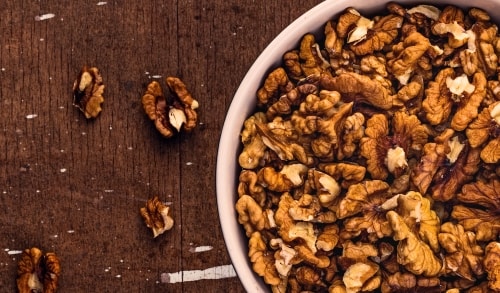
It is traditional to avoid nuts as well as vinegar-based, sharp foods, most notably the horseradish traditionally eaten with gefilte fish, since we don’t want a bitter year.
It is indeed customary not to eat nuts on Rosh Hashanah, although this seems to be mentioned only in Ashkenazi halachic literature.
A practical reason for this is given. Nuts tend to increase saliva in one’s mouth, making prayer difficult. Considering the amount of praying we do on Rosh Hashanah, and the importance of our words being enunciated clearly specifically on that day, nuts are avoided.
Another reason given is more mystical. The numerical equivalent of the word “nut” – egoz in Hebrew – is seventeen. Seventeen is also the numerical equivalent of the Hebrew word for sin, chet, not as it’s properly spelled, but as it’s pronounced. We stay far away from anything reminiscent of sin on Rosh Hashanah, nuts included.
Rosh Hashanah is a time to be especially careful with food. On the first Rosh Hashanah in history, Adam and Eve sinned by eating the wrong food. We rectify this in part on Rosh Hashanah by eating foods with auspicious allusions, and avoiding those with negative connotations.
New Fruit:
On the second night of the holiday, before we break bread (and dip it in honey), we eat a “new fruit,” something we have not tasted since the last time it was in season.
Rosh Hashanah Greetings:
When you meet a fellow Jew on the first night of Rosh Hashanah, wish him,
“Leshana tovah tikatev v’tichatem,”
or, for a female,
“Leshana tovah tikatevee v’tichatemee” (“May you be inscribed and sealed for a good year”).
After the first night, wish them a
“G’mar chatimah tovah” (“A good inscription and sealing [in the Book of Life]”).
Tashlich
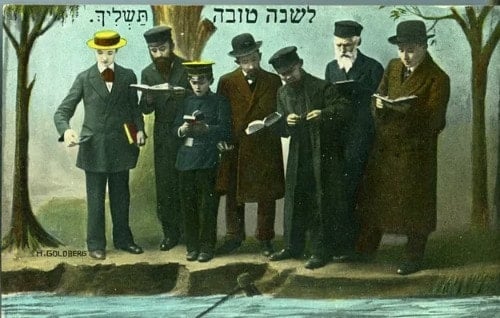
On the first afternoon of Rosh Hashanah (provided that it is not Shabbat), it is customary to go to a body of water (ocean, river, pond, etc.) and perform the Tashlich ceremony, in which we ceremonially cast our sins into the water. With this tradition we are symbolically evoking the verse “And You shall cast their sins into the depths of the sea.” The short prayer for this service can be found in your machzor.
Rosh Hashanah Prayers:
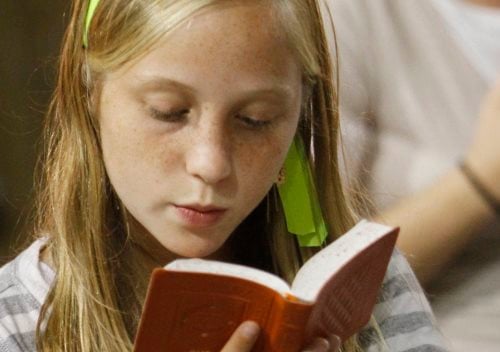
Much of the day is spent in the synagogue. The evening and afternoon prayers are similar to the prayers said on a regular holiday. However, the morning services are significantly longer.
The holiday prayerbook—called a machzor—contains all the prayers and Torah readings for the entire day. The most significant addition is the shofar-blowing ceremony. However, there are also other important elements of the prayer service that are unique to Rosh Hashanah.
Torah Readings:
ROSH HA SHANAH Day 1
- TORAH:
Genesis 21:1-34 and Numbers 29:1-6
HAFTORAH/HAFTARAH – PROPHETS:
1 Samuel 1:1 -2:10
- BRIT CHADASHAH:
1 Thessalonians 4:13-18 and 1 Corinthians 15:51-54
ROSH HA SHANAH Day 2
- TORAH:
Genesis 22:1-22:24 and Numbers 29:1-6
- HAFTORAH/HAFTARAH – PROPHETS:
Jeremiah 31:1-19
- BRIT CHADASHAH:
1 Thessalonians 4:13-18 and 1 Corinthians 15:51-54
The Torah is read on both mornings of Rosh Hashanah.
On the first day, we read about Isaac’s birth and the subsequent banishment of Hagar and Ishmael (Genesis 21:1–34). Appropriately, the reading is followed by a haftarah reading about the birth of Samuel the Prophet (I Samuel 1:1–2:10). There is a common theme in these readings: prayers for children were answered, and both births took place on Rosh Hashanah.
On the second morning, we read about Abraham’s near-sacrifice of his son Isaac, a powerful display of Abraham’s devotion to GOD, which has characterized His children ever since (Genesis 22:1–24). As mentioned above, the shofar-blowing recalls the ram, which figures prominently in this story. The haftarah tells of GOD’S eternal love for His people (Jeremiah 31:1–19).
MORE INFORMATION ON YOM TERUAH (ROSH HA SHANAH):
The Feast of Trumpets (Rosh HaShanah) was celebrated at the beginning of the month Tishri, the first month of the civil year. It was one of the seven days of holy convocation. Tishri is the seventh month of the Biblical calendar, and as such parallels the Sabbath as a special and holy time to seek YAHUVEH. The previous month of Elul is the time of preparation just as Friday is the Day of Preparation for Shabbat. This season is a time of reflection, contemplation, and putting things in order and getting right our relationship with YAHUVEH.
YAHUVEH named the other Holy Days, Sabbath, Passover, Day of Atonement. It’s simply referred to as Yom Teruah (the day of the sounding of the shofar), so it became known as the Feast of Trumpets, a special day calling attention to the coming Holy Day—the Day of Atonement (Yom Kippur). A shofar (ram’s horn) is blown during the Feast of Trumpets service.
Leviticus 23 calls the blowing of trumpets a memorial but does not say what it is a memorial of. Many believe it is a memorial of YAHUVEH’s grace to Abraham when He substituted a ram to be sacrificed instead of Isaac (Gen. 22). It is also regarded by both Jews and Christians as a memorial of the creation of the world, at which the sons of YAHUVEH shouted for joy (Job 38:7). This holiday was the new year’s day, on which the people rejoiced in a grateful remembrance of YAHUVEH’s benefits and implored His blessing for the future year.
The Feast of Trumpets and Day of Atonement (Yom Kippur) are the holiest days of the Jewish year. These ten days are called the Days of Awe or High Holy Days. Unlike other holy days, they do not celebrate a season or historical event. This season is a time for looking inward to spiritual growth. The themes surrounding this holy day include:
- Jewish New Year (Rosh Hashanah literally is “Head or beginning of the year.”)
- YAHUVEH’s Royalty (Coronation Day)
- Day of Judgment
- Remembrance (Yom Ha-Zikaron, the day of remembrance)
- Birthday of the world
New Year
The Feast of Trumpets is called the Jewish New Year. There is little resemblance between the Feast of Trumpets, one of the holiest days of the year, and a typical New Year’s Eve midnight drinking party. It is a celebration of the earth’s physical birthday on Tishri 1, the seventh month of the religious calendar, the first month of the civil calendar. It is the first of the fall holidays and usually occurs in September.
Coronation Day
Another theme of this holy day is YAHUVEH’s royalty. The shofar, in this light, announces YAHUVEH’s Kingship: With trumpets and sound of cornet [shofar] make a joyful noise before the LORD, the King (Ps. 98:6). Through repentance we become YAHUVEH’s subjects. It is said that the day that YAHUVEH manifests His Royalty, the day He created His world, is also naturally the day He sits in judgment. Coronation Day is a joyous day and world celebration.
Birthday of the World
Jewish tradition believes this day is the birthday of the world because the first part of Genesis, Bereishit, “in the beginning,” when changed around, read Aleph b’ Tishri, or “on the first of Tishri.” Therefore the Feast Of Trumpets is known as the birthday of the world (Adapted Chumney 1994).
The Shofar
The shofar has always had a special place for the Hebrew people. Trumpets were of a great variety of forms, and were made of diverse materials. Some were made of silver (Num. 10:2) and were used only by the priests in announcing the approach of festivals and in giving signals of war. Some were also made of rams’ horns (Josh. 6:8). They were blown at special festivals, and to herald the arrival of special seasons (Lev. 23:24; 25:9, 1 Chron. 15:24, 2 Chron. 29:27, Ps. 81:3 98:6). Trumpets are among the symbols used in the Book of Revelation (Rev. 1:10 8:2) (Bushnell 1995).
Specific uses for the shofar:
- It was sounded to bring Moses to the top of the mountain to receive the Commandments. And when the voice of the trumpet sounded long, and waxed louder and louder, Moses spake, and YAHUVEH answered him by a voice. And the LORD came down upon mount Sinai, on the top of the mount: and the LORD called Moses up to the top of the mount; and Moses went up (Ex. 19:19-20).
- It was a signal during time of war. And it came to pass, when he was come, that he blew a trumpet in the mountain of Ephraim, and the children of Israel went down with him from the mount, and he before them (Judges 3:27).
- It was blown at the start of the Jubilee year. Then shalt thou cause the trumpet of the jubilee to sound on the tenth day of the seventh month, in the day of atonement shall ye make the trumpet sound throughout all your land (Lev. 25:9).
- It was blown during coronation services of a new King. And let Zadok the priest and Nathan the prophet anoint him there king over Israel: and blow ye with the trumpet, and say, YAHUVEH save king Solomon (1 Kings 1:34).
- It is a sign of the regathering of dispersed Israel. And it shall come to pass in that day, that the great trumpet shall be blown, and they shall come which were ready to perish in the land of Assyria, and the outcasts in the land of Egypt, and shall worship the LORD in the holy mount at Jerusalem (Isa. 27:13).
- It was sounded as a warning of danger. Shall a trumpet be blown in the city, and the people not be afraid… (Amos 3:6).
- And the greatest anticipation of all is the day of the arrival of the Messiah. And the LORD shall be seen over them, and his arrow shall go forth as the lightning: and the Lord GOD shall blow the trumpet, and shall go with whirlwinds of the south (Zech. 9:14).
The Feast of Trumpets in Bible Times
The Feast of Trumpets in biblical times was celebrated in a far more festive fashion than it is today (Amos 8:5). Although this is a two-day holy day, preparations for this feast begin a full month in advance. On the Jewish calendar is a forty-day season called Teshuvah (return or repentance). It begins on Elul 1 and ends on the Day of Atonement (Tishri 10). This forty-day season is a time for one to annually examine his life and restore relationships between YAHUVEH and man. The first thirty days of this season are the thirty days of the month of Elul. The last ten days of this forty-day season are the Feast of Trumpets and Day of Atonement or the ten High Holy Days (Days of Awe).
This holiday is one of mixed emotions. It is considered both a happy, joyous occasion and a somber occasion: joyous because it is celebration of the new year and somber because custom has it as a “Day of Judgment” in that it is a day of looking back and taking stock of one’s life over the past year. No work is allowed on the Feast of Trumpets.
This festival has three expressions:
-
- A day of “solemn rest” to be observed on the first of the seventh month. (Cooking is permissible.)
- A memorial proclaimed with the blast of the horn (Zikhron Teru’ah).
- A day of blowing the horn (Yom Teru’ah) which indicates its chief observance, namely, the sounding of the shofar (ram’s horn) (Num. 29:1).
One Day or Two?
The Feast of Trumpets occurs at the time of the new moon. The entire Jewish calendar revolves around the moon, so it was very important to get the date of the new moon correct. In Bible times, as it is today, this feast is celebrated for two days instead of one.
A special blessing was said for the new moon: “Blessed are You, YAHUVEH, King of the universe, whose word created the heavens, whose breath created all that they contain. Statutes and seasons He set for them, that they should not deviate from their assigned task. Happily, gladly they do the will of their Creator, whose work is dependable. To the moon He spoke: renew yourself, crown of glory for those who were borne in the womb, who also are destined to be renewed and to extol their Creator for His glorious sovereignty. Blessed are You, Lord who renews the months.”
Notice that Ezra observed this feast for two days: And Ezra the priest brought the law before the congregation both of men and women, and all that could hear with understanding, upon the first day of the seventh month. And he read therein before the street that was before the water gate from the morning until midday, before the men and the women, and those that could understand; and the ears of all the people were attentive unto the book of the law. 13 And on the second day were gathered together the chief of the fathers of all the people, the priests, and the Levites, unto Ezra the scribe, even to understand the words of the law (Neh. 8:2-3,13).
A Psalm is Devoted to this Feast Day
{To the chief Musician upon Gittith, A Psalm of Asaph.} Sing aloud unto YAHUVEH our strength: make a joyful noise unto the Elohim of Jacob. Take a psalm, and bring hither the timbrel, the pleasant harp with the psaltery. Blow up the trumpet in the new moon, in the time appointed, on our solemn feast day. For this was a statute for Israel, and a law of the Elohim of Jacob. This he ordained in Joseph for a testimony, when he went out through the land of Egypt: where I heard a language that I understood not. I removed his shoulder from the burden: his hands were delivered from the pots. Thou calledst in trouble, and I delivered thee; I answered thee in the secret place of thunder: I proved thee at the waters of Meribah. Selah. Hear, O my people, and I will testify unto thee: O Israel, if thou wilt hearken unto me; There shall no strange god be in thee; neither shalt thou worship any strange god. I am YAHUVEH, which brought thee out of the land of Egypt: open thy mouth wide, and I will fill it. But my people would not hearken to my voice; and Israel would none of me. So I gave them up unto their own hearts’ lust: and they walked in their own counsels. Oh that my people had hearkened unto me, and Israel had walked in my ways! I should soon have subdued their enemies, and turned my hand against their adversaries. The haters of YAHUVEH should have submitted themselves unto him: but their time should have endured for ever. He should have fed them also with the finest of the wheat: and with honey out of the rock should I have satisfied thee (Ps. 81).
The ceremony of the blowing of the shofar was a magnificent sight. The priest chosen to blow the shofar was trained from childhood. On the first day of this feast, the priest blowing the shofar stood outside the Temple with two trumpeters. The shofar represents, among other things, a call to awaken the conscience.
Messianic Significance of Rosh Hashanah
The blowing of trumpets is a sign of the return of YAHUSHUA and memorial of YAHUVEH’s grace to Abraham when He substituted a ram to be sacrificed instead of Isaac (Gen. 22). Isaac is a type of foreshadowing of YAHUSHUA. Just as Abraham offered his son on the altar, YAHUVEH offered His son on Calvary’s altar. Hebrews 11:17-19 says “By faith Abraham, when he was tried, offered up Isaac: and he that had received the promises offered up his only begotten son, Of whom it was said, That in Isaac shall thy seed be called: Accounting that YAHUVEH was able to raise him up, even from the dead; from whence also he received him in a figure.” Both Isaac’s and YAHUSHUA’s births were miracles. Both were obedient to the point of sacrifice.
Trumpets were used in giving signals of war. YAHUSHUA is the commander of the army of YAHUVEH. The Jewish people were looking for a deliverer who would defeat the Roman army. YAHUSHUA came, the first time, to defeat the work of satan and the sin in men’s hearts. And having spoiled principalities and powers, he made a shew of them openly, triumphing over them in it (Col. 2:15).
In the same way this feast speaks to the Christian about spiritual warfare. Put on the whole armour of YAHUVEH, that ye may be able to stand against the wiles of the devil. For we wrestle not against flesh and blood, but against principalities, against powers, against the rulers of the darkness of this world, against spiritual wickedness in high places. Wherefore take unto you the whole armour of YAHUVEH, that ye may be able to withstand in the evil day, and having done all, to stand. YAHUSHUA is our armor because He defeated satan. When we put on YAHUSHUA we will triumph over evil forces (Eph. 6:11-13).
The Feast of Trumpets can be a very special time for believers in YAHUSHUA. Our sins are not forgiven just when we “believe.” James 2:19 says “Thou believest that there is one YAHUVEH; thou doest well: the devils also believe, and tremble.” To be forgiven, we must have a repentant heart. We must come in submission to our Heavenly Father, asking for forgiveness, knowing that He will forgive us, as a father forgives his child. That forgiveness which we seek has been guaranteed–bought and paid for by YAHUSHUA’s atoning sacrifice on the tree.
Baptism?
Evidence shows that YAHUSHUA was born in the fall (see The Feast of Tabernacles chapter). It is believed that His baptism was also in the fall. After YAHUSHUA’ baptism, He spent forty days in the wilderness. Then was YAHUSHUA led up of the Spirit into the wilderness to be tempted of the devil. And when he had fasted forty days and forty nights, he was afterward an hungered (Matt 4:1-2.) It is possible these forty days parallel the forty-day season called Teshuvah (return or repentance). Some believe that this is the time that YAHUSHUA began His ministry, at the end of the forty days when he began to declare His message. From that time YAHUSHUA began to preach, and to say, Repent: for the kingdom of heaven is at hand (Matt. 4:17).
Prophetic Significance
The Feast of Trumpets is a major festival. The three major festivals are Passover, Pentecost and Feast of Trumpets. We know Passover represents the sacrifice of YAHUSHUA, and Pentecost represents the coming of the RUACH ha KODESH (Holy Spirit), so it stands to reason that the Feast of Trumpets represents a very special time.
The trumpet was the signal for the field workers to come into the Temple. The high priest actually stood on the southwestern parapet of the Temple and blew the trumpet so it could be heard in the surrounding fields. At that instant the faithful would stop harvesting, even if there were more crops to bring in, and leave immediately for worship service (Levitt 1979, 12). The Feast of Trumpets will be the Rapture of the Bride of YAHUSHUA.
The Wedding
For the Lord himself shall descend from heaven with a shout, with the voice of the archangel, and with the trump of YAHUVEH: and the dead in YAHUSHUA shall rise first: Then we which are alive and remain shall be caught up together with them in the clouds, to meet the Lord in the air: and so shall we ever be with the Lord (1 Thess. 4:16-17).
YAHUSHUA will fulfill the fall holy days by coming on the Feast of Trumpets to catch away His Bride to celebrate the Marriage Supper of the Lamb in Heaven, then return to earth seven years later on the Day of Atonement to establish His Kingdom beginning on the Feast of Tabernacles.
YAHUSHUA Fulfills the Seven Feasts of Israel:
Rabbis have taught that after being resurrected on the Feast of Trumpets, the righteous (the Bride, but not the church as is erroneously being taught now) would enter the chupah, or wedding canopy to spend seven years while the “day of trouble” [tribulation], the seven years of judgment occurs on earth. By examining an ancient Jewish wedding, we can more clearly see the picture of the union of the Church (the bride) with the Messiah.
When a man in ancient Israel married, he went to the bride’s house with a “bride price” and made a contract (covenant) with the girl’s father. If the father accepted the man and his bride price, the man would pour a glass of wine. If the girl drank it, it would indicate that she accepted the man’s proposal and they were betrothed. The man would go away and prepare a wedding chamber for his bride. When the man’s father deemed that the wedding chamber was ready, usually one to two years later, the man would return to the bride’s house and “steal” her away “like a thief in the night” at an hour when no one would suspect. He would take her to the wedding chamber for seven days. During this time, the groom’s father would hold a party to announce the marriage. At the end of the seventh day, the married couple would emerge from the chamber and partake of the marriage supper.
The ancient Jewish wedding is a picture of YAHUSHUA the Bridegroom and His Bride. The contract (covenant) was sealed at the Last Supper when YAHUSHUA shared the covenant cup with His Disciples. And he said unto them, This is my blood of the new testament, which is shed for many (Mark 14:24).
YAHUSHUA, in speaking to the Disciples after the last supper said the same words that any Jewish man would tell his betrothed. In my father’s house are many mansions; if it were not so, I would have told you. I go to prepare a place for you. And if I go to prepare a place for you, I will come again, and receive you unto myself; that where I am, there ye may be also (John 14:2-3).
And, of course, YAHUSHUA paid the “Bride price” with His life. The marriage of the Bride to YAHUSHUA is described in several Bible texts. Let us be glad and rejoice, and give honour to him: for the marriage of the Lamb is come, and his wife hath made herself ready. And to her was granted that she should be arrayed in fine linen, clean and white: for the fine linen is the righteousness of saints (Rev. 19:7-8). The Jewish wedding ceremony is another beautiful shadow of YAHUSHUA’s return.
Teshuvah and Days of Awe
The forty-day season called Teshuvah (return or repentance) starts thirty days before the Feast of Trumpets, and is a shadow of YAHUVEH’s prophetic plan. The entire ten days from the first day of the Feast of Trumpets through the Day of Atonement are known as the Days of Repentance or Days of Awe. The days between may be a picture of the tribulation. The days between the Feast of the Trumpets and Day of Atonement reflect the seven-year period of Jacob’s Trouble. Alas! for that day is great, so that none is like it: it is even the time of Jacob’s trouble; but he shall be saved out of it (Jer. 30:7). The days are divided as follows:
- The thirty days of the month of Elul —the Bride
- The Day of the Feast of Trumpets—the Rapture of the Bride.
- The days between the Feast of Trumpets and Day of Atonement—Tribulation
- The Day of Atonement—the Second Coming
For thirty days the shofar is blown every morning in the Synagogue to remind the people that the holy days are approaching, in order that they may prepare themselves. Their preparation consists of confessing their sins and seeking forgiveness along with a change in life, if needed. The Jews’ earnest prayer is that their names may be written in the Book of Life (Wagner 1995). This might represent the period before the rapture—calling people to repentance. One’s name is written in the Book of Life only when he or she has a repentant heart and comes in submission to our Heavenly Father, asking for forgiveness through YAHUSHUA’s death and resurrection.
Coronation of YAHUSHUA, Our King
And to the angel of the church in Philadelphia write; These things saith he that is holy, he that is true, he that hath the key of David, he that openeth, and no man shutteth; and shutteth, and no man openeth; I know thy works: behold, I have set before thee an open door, and no man can shut it: for thou hast a little strength, and hast kept my word, and hast not denied my name. Behold, I will make them of the synagogue of Satan, which say they are Jews, and are not, but do lie; behold, I will make them to come and worship before thy feet, and to know that I have loved thee. Because thou hast kept the word of my patience, I also will keep thee from the hour of temptation, which shall come upon all the world, to try them that dwell upon the earth. Behold, I come quickly: hold that fast which thou hast, that no man take thy crown (Rev. 3:7-11).
Daniel 7:9-14 also speaks of the Messiah returning to reign as king: I beheld till the thrones were cast down, and the Ancient of days did sit… thousand thousands ministered unto him, and ten thousand times ten thousand stood before him: the judgment was set, and the books were opened [The Day of Judgment]. I beheld then because of the voice of the great words which the horn spake: I beheld even till the beast was slain, and his body destroyed, and given to the burning flame. As concerning the rest of the beasts, they had their dominion taken away: yet their lives were prolonged for a season and time. I saw in the night visions, and, behold, one like the Son of man [YAHUSHUA] came with the clouds of heaven, and came to the Ancient of days, and they brought him near before him. And there was given him dominion, and glory, and a kingdom, that all people, nations, and languages, should serve him: his dominion is an everlasting dominion, which shall not pass away, and his kingdom that which shall not be destroyed.
In Revelation, chapters 8 through 10, the seven trumpets and the “Mystery of YAHUVEH” are revealed at the final blast: And the angel which I saw stand upon the sea and upon the earth lifted up his hand to heaven, And sware by him that liveth for ever and ever, who created heaven, and the things that therein are, and the earth, and the things that therein are, and the sea, and the things which are therein, that there should be time no longer: But in the days of the voice of the seventh angel, when he shall begin to sound, the mystery of YAHUVEH should be finished, as he hath declared to his servants the prophets (Rev.10:5-7).
Remember, you should have joyful expectations (Titus 2:13) and be patiently waiting in obedience (1 Cor. 1:7, 1 Tim. 6:14). Celebrate Rosh HaShanah by teaching your children about repentance, renewing your heart toward YAHUVEH, and looking forward to the Rapture of YAHUSHUA’s Bride.
Traditional Jewish foods accompany Rosh HaShanah. Typically, a blessing will be said over two loaves of bread, known as challah. The round shape symbolizes a crown, a reminder of the kingship of YAH. Challah also stands for the circle of life, and the hope that our lives endure without end.
Challah is sometimes baked with a ladder on top in recognition that only YAH decides who climbs up or down the ladder of life. Forming challah in the shape of a bird is also done. The Torah says that YAH will protect Jerusalem in the same way a bird hovers.
Apples dipped in honey are another Rosh HaShanah tradition. It symbolizes the hope for a “sweet year” ahead. Honey is spread on challah. Tzimmes, a mixture made from carrots, cinnamon, yams, prunes, and honey, is also traditional.
![[YAHUSHUA HA MASHIACH] THE CHIEF CORNERSTONE MINISTRY](https://sharathroshpinnah.files.wordpress.com/2017/09/days-of-awe.png)

